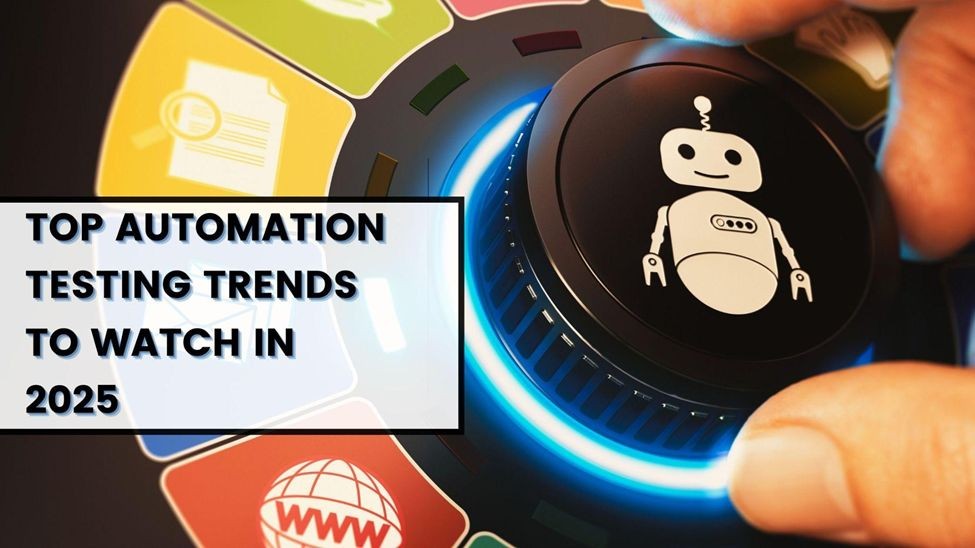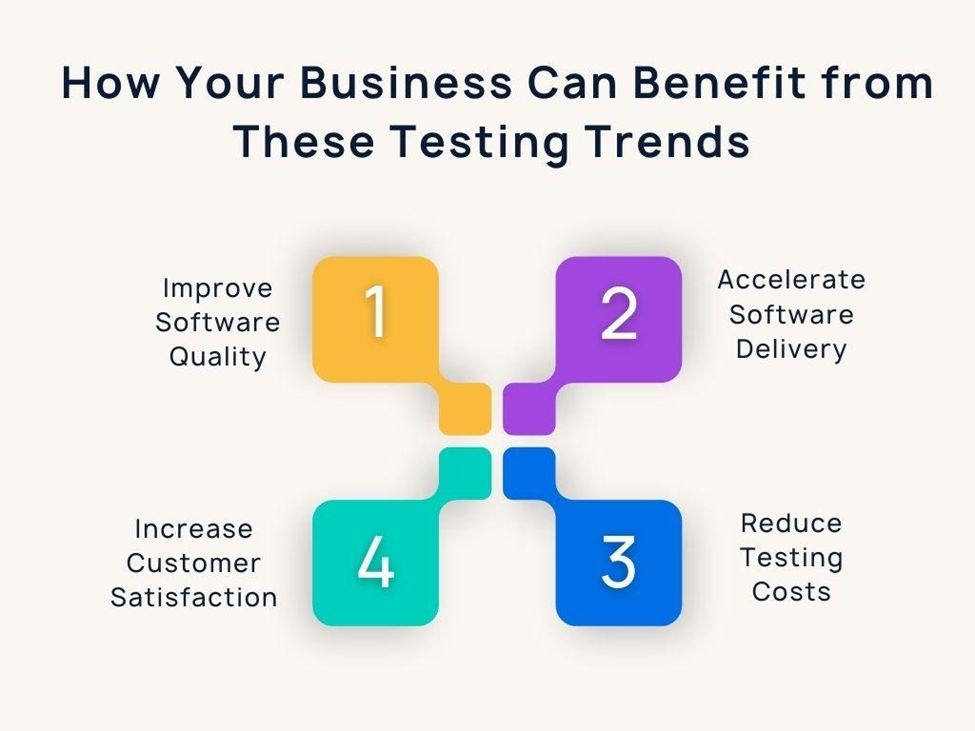
Technology evolves at such rapid speed since new products and upgraded devices appear in increasingly shorter intervals. The fast-paced product development cycle needs reliable testing methodologies that manual testing methods can no longer deliver. Automation testing services represent a modern development strategy powered by technological resources that enhance speed and efficiency of development processes.
However, even automation is evolving. Many substantial innovations will transform automated testing services by 2025. This article explores a few of those significant automation testing trends that will transform the QA approach as we know it.
Why the Shift in Test Automation?
Automation testing is always changing because of the dynamic nature of the present-day software development environment. The way we approach automated testing is changing significantly due to a number of important variables, which are moving us away from conventional approaches and toward more sophisticated and all-encompassing solutions. Some of them are as follows:
- Demanding Consumers: Current business clients look for both fast delivery of high-end software applications. Today’s consumer base does not tolerate slow product development along with defective releases because they demand high quality and quick delivery. The need for quicker efficient testing processes requires advanced services and tools for automation testing to succeed.
- Increased Cyber Threats: Security testing has become essential because cyberattacks have increased rapidly. Through automated testing organizations can perform detailed security checks more time-efficiently which protects their applications from vulnerabilities.
- The Rise of AI: The fast progress of artificial intelligence (AI) technology leads software development into newer possibilities. The integration of artificial intelligence has transformed automation testing tools into devices that expand test coverage along with precision testing while reducing overall execution time.
- Mobile-First World: Due to the exponential rise in mobile device usage organizations require reliable mobile testing services. Automated testing enables testing organizations to perform effective assessments of mobile platforms alongside different devices that use multiple operating systems.
- Need for Speed and Efficiency: Every business requires quick and efficient software delivery as a competitive necessity. The implementation of scriptless test automation and comprehensive test automation solutions speeds up testing cycles while shortening time-to-market dates.
The factors are why automation testing has transitioned while the industry moves toward smarter and adaptable and complete solutions. Business success can be achieved through these changes by improving both software quality and delivery speed while generating higher satisfaction from customers.
Key Automation Testing Trends for 2025
Here are the top automation testing trends that are expected to dominate the industry in 2025:
- AI-Powered Testing: The Rise of Intelligent Automation
Technology based on artificial intelligence now forms a part of every human experience including software testing operations. The adoption of AI and machine learning (ML) technologies will experience rapid growth during 2025 for automation testing purposes. The integration will lead to multiple innovative applications during 2025.
- Agentic AI: Machine-learning agents will independently perform complete testing operations, including selecting & executing tests, analyzing results, and suggesting fixes. The availability of automatic testing enables skilled personnel to dedicate themselves to refined quality assurance work that human intelligence possesses.
- AI Shift-Right: AI analysis of user interactions within production helps prevent issues by monitoring actual behavior patterns and enhances testing through real usage data.
- AI-Powered Testing Platforms: The combination of AI-driven platforms generates end-to-end automation for testing operations, which includes test case development, execution and result analysis.
- Democratization of Testing
High-end test automation solutions that use low code or no code enable staff members who lack programming skills to join quality assurance activities. Stakeholders from business analysis, product ownership, and other groups now have opportunities to join testing activities through this approach, leading to better collaboration. The test democratization process extends testing opportunities to more people who bring varied perspectives which makes software testing more comprehensive while producing better quality software.
The rise of scriptless test automation platforms serve as essential enablers of this trend since they offer user-friendly interfaces and intuitive functionalities to testers. Existing testing tools allow organizations to select between broad test automation solutions and mobile testing services that expand their QA team while fostering team connection.
- The Evolving Role of the Tester
The testing domain undergoes evolution because regular testing duties shift to AI and automation systems. The testing profession now requires testers to serve as quality advocates who think strategically while executing test cases. The professionals are examining AI alongside DevOps and test automation while focusing their practice in these areas:
- Test Strategy: It identifies the complete testing framework and states its alignment with company targets.
- Risk Assessment: Testers need to identify potential risks through assessments to set proper testing priorities.
- Performance Analysis: The performance evaluation stage examines performance constraints to ensure optimal user experience.
- Security Testing: Project security requires developers to design complete security testing procedures that defend against electronic intrusions.
The altered focus in testing requires testers to pursue continuous growth in their abilities, which includes acquiring a broader understanding of software quality standards.
- End-to-End Autonomous Quality Platforms
Self-governing end-to-end (E2E) quality systems have emerged as the industry standard for controlling all elements of software quality. These systems provide a single solution for a variety of testing requirements, including functional, performance, security, and usability testing. The testing lifecycle is optimized using AI approaches and automation testing methodologies, which include test case generation and execution analysis phases.
Organizations experience streamlining of their testing operations and reduced complexities while boosting productivity through complete quality platform adoption. E2E autonomous quality platforms serve as an effective solution for achieving complete quality assurance throughout all stages of testing whether you need end-to-end automation or seek improvements in existing automation testing services.
- Integrating Testing with DevOps and SRE
Modern development speed requires operational resilience along with continuous delivery as primary priorities. Organizations enhance testing capabilities by merging it with DevOps and Site Reliability Engineering (SRE) frameworks to reach these goals. Testing works as an organized ongoing process throughout all phases of software development life cycle because of this essential integration.
A CI/CD pipeline benefits from testing integration because it produces the following outcomes:
- Accelerate Feedback Loops: Shallow testing feedback processes help developers detect defects right away during the early stages of development.
- Implement Proactive Quality Assurance (QA): Performance systems will be monitored to find issues that could affect user experience.
- Foster Improved Collaboration: Teamwide quality ownership and cross-team communication are strengthened through the process.
- Growth of Contextual Testing
Modern software must operate seamlessly for a heterogeneous user demographic utilizing varied devices, locales, and preferences. This is when contextual testing is applicable. This trend includes evaluating apps under diverse real-world situations, including varying operating systems, browsers, network speeds, and geographical locations.
By using contextual testing, enterprises can guarantee that their software accommodates varied user requirements and provides a uniform experience. This is especially vital for mobile testing services, where fragmentation among devices and operating systems is common. Utilizing automation testing tools and scriptless test automation platforms may enhance contextual testing and guarantee thorough coverage.
How Your Business Can Benefit from These Trends

Maintaining a competitive edge in automation testing can have a substantial impact on your organization. By embracing the trends discussed above, your organization can:
- Improve Software Quality: Improve the quality of software by identifying potential issues earlier in the development process and enhancing test coverage.
- Accelerate Software Delivery: By outsourcing repetitive tasks and seamlessly incorporating testing into the development lifecycle, the time-to-market can be reduced.
- Reduce Testing Costs: Minimize the necessity for manual testing and optimize testing efforts, which will lead to cost savings.
- Increase Customer Satisfaction: Provide a positive experience and deliver high-quality software that meets user expectations, resulting in increased customer satisfaction and loyalty.
Whether you are utilizing comprehensive automation testing services, investigating automation testing tools, or implementing a full test automation solution, these trends provide a route to improved efficiency, quality, and customer satisfaction.
Concluding Thoughts
The year 2025 is anticipated to be pivotal for automated testing. The integration of AI, the evolution of tester roles, and sophisticated testing platforms will transform our approach to quality assurance. By comprehending and embracing these developments, businesses may guarantee they are optimally positioned to provide high-quality software in a progressively demanding market. Staying informed and proactive is key to success in this dynamic field.
Understanding these trends is essential, whether you want full automation testing services, explore automation testing technologies, contemplate scriptless test automation, or require a complete test automation solution for mobile testing. The future of testing has arrived, propelled by innovation.